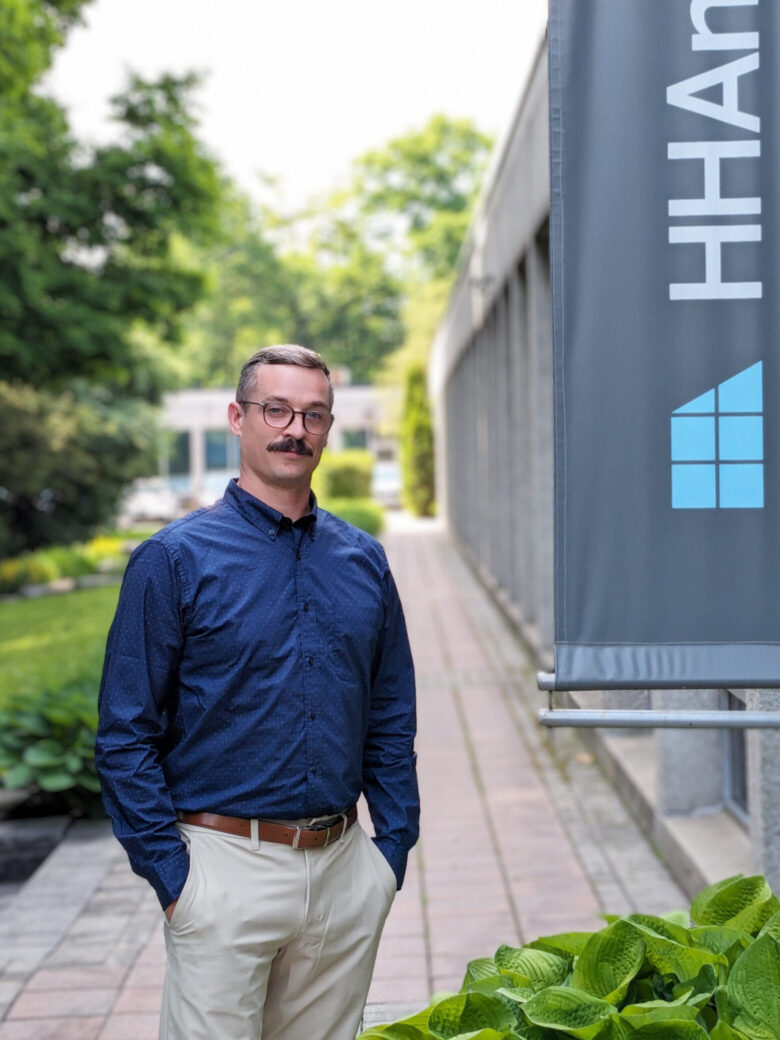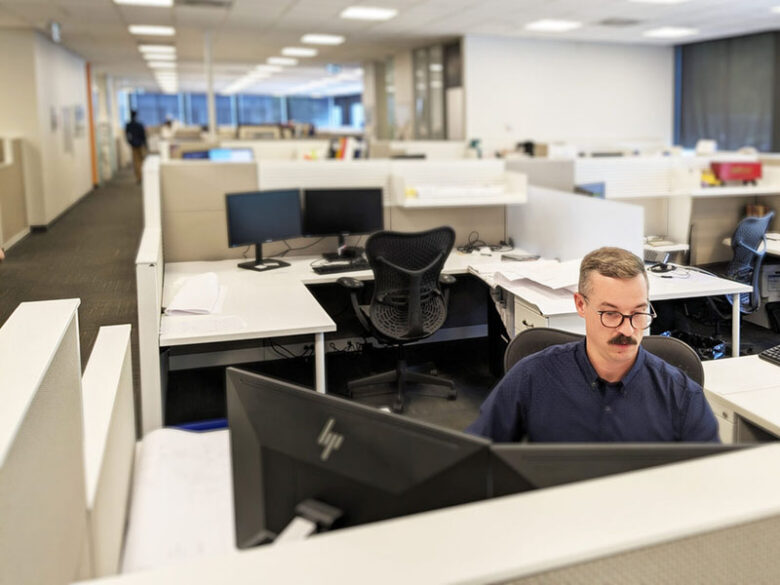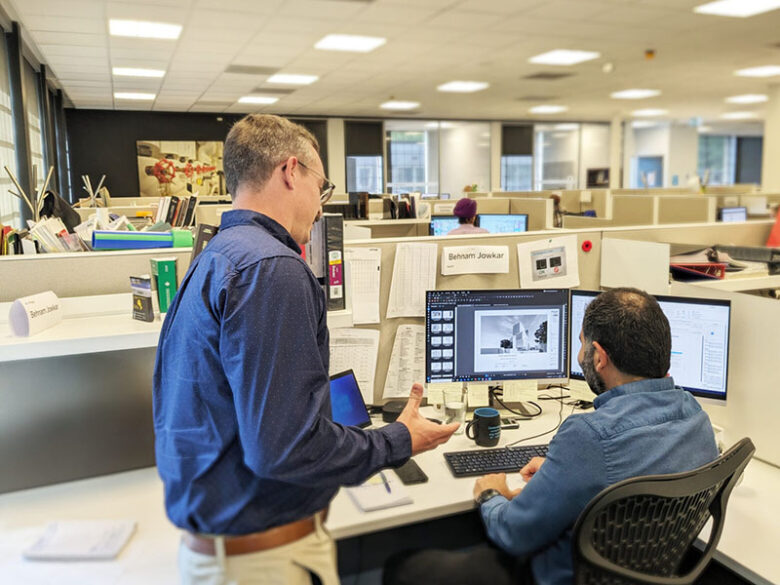Meet David Rose – Senior Project Manager

David joined HH Angus in 2022.
David, you came to engineering after working in the construction industry. How did that change come about?
Even in high school, I always liked construction. I worked on construction projects and mine sites during the summers. I didn't realize at that time what engineering was. It wasn't until I moved out of the Yukon and went down to Alberta to work with an engineer that I realized, ‘OK, so this is what engineers do, I like this!” That was a great opportunity. The engineer convinced me to go back to school for an engineering degree, then brought me on board and began mentoring me. And once I got started, I never looked back.
What specifically attracted you to work at HH Angus?
I was taking a Tech diploma in Calgary when I met my wife and subsequently moved to Montreal. I finished my degree at Concordia University here in Montreal, and began working on the CHUM project (Centre hospitalier de l’Université de Montréal). At the time, it was the largest healthcare P3 in North America, so it was massive. Due to its sheer size, it absorbed a large part of the talent pool of engineers in Montreal, which gave me the opportunity to work with some of HH Angus’ key people on the project, such as Nick Stark, Mohamed Kamel, Paul Seager, Michel Vidori, Wael Atallah and others.
I worked closely with HH Angus’ project staff for about four years and got to know the team quite well. I became aware that the firm works on really interesting projects and employs some of the most talented people I know in the industry. So, when my contract ended with the construction company, I reached out to Mohamed to see if HH Angus needed anyone, and that's how I came to be here.
Can you describe your role as a Senior Project Manager?
Well, I'm lucky. Being a Senior Project Manager, I get to work on some of the company’s large marquee projects; for example, I currently have two significant healthcare projects underway.
The project management role is actually 90% communications so that I can plan, monitor and manage the process. It involves communicating with all the stakeholders - whether that’s being client facing with the architect, or identifying and managing risks on the project and trying to mitigate them, it’s about making sure that we have all the decisions documented throughout the life of the project. That helps everyone, especially further down the road, so we can look back to see the context in which a decision was made. Documenting why decisions were made and who made them helps mitigate liability risks so it’s an important part of the process.
And managing and following up on the schedule and the budget is a key part of the role as well. Project management touches on so many aspects of a project, and it’s not as technical a role as some of our design leads.
Tell us about some projects you've been working on and what you like about them.
One of the things that differentiates HH Angus is the sheer volume of high-value, complex and interesting projects. That’s one of the factors that brought me here - the company doing the most interesting work was HH Angus.
Obviously, I'm very proud of the work I did on CHUM. I’m also proud of our current work at the Toronto Western Hospital’s new 15-storey patient tower. It's a very collaborative project with Dialog Architecture, EllisDon, and Plan Group, and it's going exceptionally well. The new Ottawa Civic Hospital is another exciting project. It’s a very large P3, similar in size to CHUM, so I’m looking forward to how that develops. And I’m also involved in some highly confidential energy and mission critical projects that I’m not at liberty to discuss, but those are really interesting as well.
How have you grown professionally since working at HH Angus?
HH Angus does a really good job of fostering the environment to grow professionally. They provide me with the opportunity to work on some key projects and to do what I'm good at. That allows me to grow in my career, develop working relationships, and pursue ongoing education. Plus, there's a lot of mobility and opportunity within the firm - the company has been nothing but supportive of me getting additional credentials, such as my PMP certification.
You spoke earlier about being mentored when you first started out your career. Was there any advice you received back then that you still use today and that was instrumental in how you approach your work?
One is “leave your bias at the door and do your best”. People can get entrenched in their opinions and our job as consulting engineers is to focus on solving the problem and not bringing a bias to the problem. It can sometimes be a challenge to do that, but that's one piece of key advice that I still use today.
Another is to take a really complicated challenge and break it down into simple pieces by asking very binary ‘yes’ or ‘no’ questions. When somebody tells you something is too complicated, it’s helpful to dissect that to a point where it's not actually too complicated so you can make a decision on it. That advice has also served me very well as a project manager.
If you're talking to someone who's not in the AEC industry, ow do you describe what you do?
I tell people that I help ensure that HH Angus is delivering a quality product on time and on budget. That's really the bulk of my role, along with mitigating our risks. Plus, I get to interact with the design leads, making sure we're on schedule, that we're delivering everything we need to deliver, and that we've captured all of the client's requirements.
How exactly do you ensure that we're delivering on time - what's involved in that aspect of your role?
Setting expectations early plays a huge part, and not just saying arbitrarily “yes, we can meet that date” without first thinking about it, planning it, and considering all the aspects of the project. What I try to do is manage expectations; for example, if we have a target delivery date, what do we need to achieve that date? We capture all the information that we need from the architects and other consultants. Then we set the expectation with architects that they need to freeze their plans in a way that allows us enough time to move forward to the deliverable. So, a lot of it is just planning and setting expectations.
How do you then work with our internal team to make sure they are delivering the work on schedule?
I work very closely with the design leads, and we touch base every other day. There are always issues to address so we need regular checkpoints to track where we are in the timeline, how things are going, how we're progressing, what's being done, and what still needs to be done. The key word is the regular follow-up with the team.


What part of your job do you enjoy the most?
I love all of it! I get to do what I’m good at as a project manager, communicating with everybody, managing a lot of different tasks, and I get to see the technical aspects when I’m working with the design leads. I’m also client facing and serve as a key player in the project. I really do love my role.
What are some of the current trends and new directions in the AEC sector that you find interesting?
From a project delivery standpoint, we're doing a lot more integrated projects. One of my current projects is a Guaranteed Max Price where we have the contractor involved very early. I'm a former contractor, so that's definitely a different process than the one I was used to, and it requires a lot of collaboration. It's positive in the end because we're delivering a high-quality project at a fast-track pace. And I think everybody on that job is very happy.
Another procurement model that we're going to more often is IPD, the Integrated Project Delivery model, which is similar in that it has all parties at the table, including the contractor. The contractors are on board very early and contributing to the project, so that's definitely becoming a trend.
Do you find differences in approach as you move from a project in one sector to one in a different industry?
Absolutely. For example, in the high technology sector, it's very time driven - time is the key factor. The clients have very high expectations and a clearly established process, and things move at a very fast pace. They are usually also very large corporations with layers of bureaucracy, and they're very defined in what the process looks like. Projects in the healthcare sector are also fast-paced, but with different types of stakeholders and different priorities.
What does it take to be a good Senior Project Manager?
First and foremost, as I mentioned earlier, good communication skills. You have to be able to communicate clearly and effectively. And this may sound odd, but it helps to be easy to work with - which can be a bit challenging because the Project Manager is usually the person who has to say ‘no’, to establish limitations, and set expectations. Executing the role so you're not coming across negatively is the key. And of course carrying out the necessary follow-up on all tasks.
What would you say to someone considering applying to HH Angus?
I would “do it!” There's a lot of opportunity here. We have some of the most experienced people in the industry working across Canada and internationally in a variety of disciplines. You see it every day, so many colleagues have been here for 25 plus years and there’s a reason for that. Back when I was looking around myself, I was speaking with my former mentor about various opportunities and he said “Go with HH Angus, they have some of the most experienced people that I’ve ever worked with, and they do the most interesting projects!”
